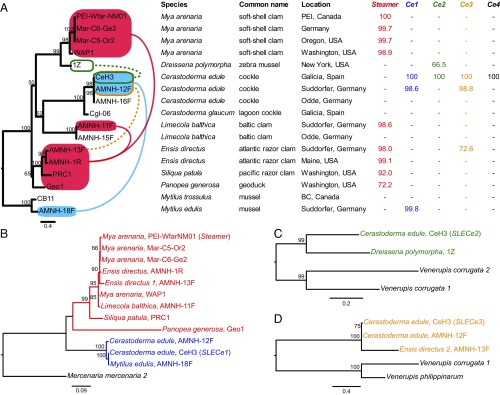Fig. 2.
Polymorphism within species and evidence for multiple, recent HTT between bivalve species. (A, Left) A phylogenetic tree of COI sequences from multiple individuals from multiple locations is shown. Proposed HTT events are shown as lines indicating likely routes of transfer of Steamer (red) from E. directus to M. arenaria and L. balthica and of SLECe1 (blue) between M. edulis and populations of C. edule. Dotted lines between sequences similar to SLECe2 and SLECe3 show more distant relationships. The SLECe1 sequence from the individual used as a reference here (CeH3) is 99.2% identical to the previously published sequence from a different individual in the same population (KX018578). (Right) The Steamer-like elements found in each individual sample are shown. Columns correspond to the distinct elements found in M. arenaria and C. edule: Steamer (red), SLECe1 (blue), SLECe2 (green), and SLECe3 (brown). The first member of each group identified is the reference and is listed as 100%. If a member of that group was detected in the sample, the percent identity compared with the group reference is shown (treating gaps as missing data). Samples negative for PCR amplification of each group are marked as “−.” (B) Phylogenetic tree of the SLE clade including Steamer and SLECe1 sequences, rooted with the sequence from M. mercenaria. (C) Phylogenetic tree of SLECe2 and closely related sequences. (D) SLECe3 and closely related sequences. The sequence from S. patula has a single frameshift mutation, the sequence from P. generosa has two closely spaced frameshift mutations that maintain an ORF, and the sequence from D. polymorpha has four frameshift mutations.

